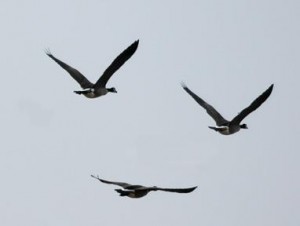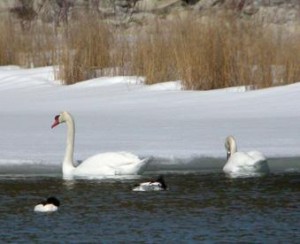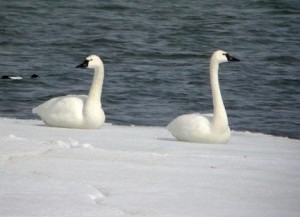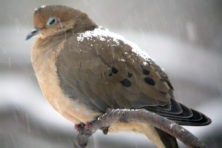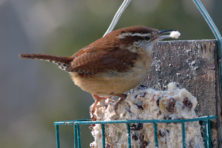The Christmas Bird Count
- Share
- Tweet
- Pin
- Share
A statement used in advertising in the past, “You’ve come a long way, baby!” could apply very appropriately to the annual Christmas Bird Count (CBC) which has become so popular throughout this continent over the past 109 years. These annual early winter counts are sponsored by the National Audubon Society and the U.S. Fish and Wildlife Service (USFWS), and the counts were begun by a group of interested and very concerned nature enthusiasts in 1900.
They were motivated by Frank Chapman, curator of ornithology at the American Museum of Natural History, and begun in protest to the original Christmas Day “slaughter.” This heinous annual event, on Christmas Day of all days, had so-called “sportsmen” out east vying for the title of who could shoot and kill the most animals – bird or mammal, practically any wild creature that moved – on that special day when millions of people were celebrating a great spiritual birth. The bird counters wished to publicize conservation rather than the destruction of wildlife and eventually won out.
About 50,000 people participate in approximately 1,200 different CBC’s in the United States. What’s ideal is that virtually anyone can participate, some looking through windows in their home to count the birds coming to their feeders, other people searching for and tabulating birds seen along roadsides, in fields and woods, along the shores and on the water. Each count has a compiler and, ideally, individuals or small groups are assigned to count in a very special area within a circular count zone with a diameter of 15 miles.
Today the Wisconsin Society for Ornithology (WSO) coordinates the state’s 80-plus counts. These events will significantly contribute to the records of the WSO and USFWS in that they will: (1) indicate trends in expansion or reduction of the range of a bird species, (2) record greater flights or irruptions of species into the state, species such as Great Gray and Snowy Owls, Evening Grosbeaks, Common Redpolls or Tundra Swans, and (3) help ornithologists to follow fluctuations or dramatic changes in bird populations.
A socially awaited annual birdwatchers’ highlight is the potluck “rally tally” following the day’s count; this in addition to the pre-dawn breakfast sponsored by some counts whereby routes are reviewed, strategies planned, a noon lunch stop agreed upon, and great conversation is enjoyed. More than once in previous years, while waiting outside for the early risers to arrive for the breakfast at our home, I’ve heard Great Horned Owls calling in the distance, clearly announcing their presence in the count area. Yes, a lot of counters listen for owls during the early and late hours of the day and, yes, one can count a species by hearing their calls or songs.
Contrary to normal assumptions, the CBC’s are not contests to see who can amass the most bird species in a day. Actually, negative reports are also of considerable value to the long-range studies of wintering birds. However, I must admit that we take each count very seriously and try to not miss any birds. Experience has taught us that three or four birders, riding together in one car and carefully scanning the terrain and trees in all directions don’t miss a lot of birds. They also tend to greatly intensify the pleasure of seeing some rare species.
We maintain that when a person can look over records of a CBC taken 51 years ago (mine began in 1958, with Charlotte doing her 38th this year), and clearly recall some rather minute but exciting details, these are extremely memorable and worthwhile experiences to plan for and to complete. What’s so important is documenting these events. Ours are written, in rather extensive details, in a CBC notebook to which we refer frequently.
Our high total CBC to date was the Sturgeon Bay count of Dec. 15, 2001 when 72 species and 14,497 individual birds were counted. One point is certain – it pays off to have several of the parties in the field equipped with spotting scopes, especially those scanning the shore areas. It is during a count day, when the winds are very calm and there has been little ice build-up along the shores, that high waterfowl counts can be accomplished. Every few years a very special addition is made to the total count, such as were the 224 American Robins tabulated on the Sturgeon Bay count of 1998.
Canada Geese, specifically the giant race of these geese, have invariably been the high-count species of our recent CBC’s. The large flocks entered the Door County scene between 20 and 25 years ago. Our record so far, established on the 2003 Sturgeon Bay count, was 4,945 Canada Geese. Bear in mind that the giant race is non-migratory. They don’t fly any farther south for open water and food than they have to. What you are seeing now are the adults and those young hatched during this past summer, plus those hatched in this area during the summer of 2008. This coming spring the young of 2009 will fly northward on their so-called “molting migration,” spend the summer far to the north molting, feeding, and then return to Door County in fall where they had been fledged the year before. This pattern surely accounts for the gradual huge build-up of the giant race that we and many others are experiencing.
Lately we’ve been happy to observe small numbers of Tundra Swans along with a lesser number of Mute Swans along the Lake Michigan side of the county. Large white waterfowl in the distance, feeding or resting, can be either species. A fairly close look is required to be able to see the orange bills of the Mute and the black bills of the Tundra Swans.
Watch for future announcements and plan to participate in the 2009 Door County CBC’s. The Northern Door count will be on Dec. 19. Call the Ridges Sanctuary at 920.839.2045 if you’d like to help. The Sturgeon Bay count also will be conducted on Dec. 19, and the Brussels (Southern Door) count will be Dec. 20. Call Charlotte Lukes at 920.823.2478 if you wish to participate in one or both of the latter two counts. You’ll be glad you did – and so will the birds!

